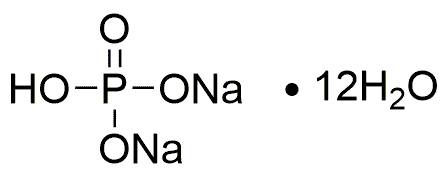Sodium phosphate dibasic dodecahydrate is widely utilized in research focused on:
- Food Industry: It serves as a food additive, helping to maintain the texture and moisture of processed foods, enhancing their shelf life and quality.
- Pharmaceuticals: This compound is used in the formulation of various medications, acting as a buffering agent to stabilize pH levels, which is crucial for drug efficacy.
- Laboratory Reagents: It is commonly employed in laboratories as a reagent in biochemical assays, particularly in the preparation of phosphate buffers essential for enzyme reactions.
- Water Treatment: Sodium phosphate dibasic dodecahydrate is utilized in water treatment processes to prevent scale formation and corrosion in industrial systems, improving operational efficiency.
- Agriculture: It acts as a fertilizer, providing essential phosphorus to plants, which is vital for root development and overall growth, thus enhancing agricultural productivity.
General Information
Properties
Safety and Regulations
Applications
Sodium phosphate dibasic dodecahydrate is widely utilized in research focused on:
- Food Industry: It serves as a food additive, helping to maintain the texture and moisture of processed foods, enhancing their shelf life and quality.
- Pharmaceuticals: This compound is used in the formulation of various medications, acting as a buffering agent to stabilize pH levels, which is crucial for drug efficacy.
- Laboratory Reagents: It is commonly employed in laboratories as a reagent in biochemical assays, particularly in the preparation of phosphate buffers essential for enzyme reactions.
- Water Treatment: Sodium phosphate dibasic dodecahydrate is utilized in water treatment processes to prevent scale formation and corrosion in industrial systems, improving operational efficiency.
- Agriculture: It acts as a fertilizer, providing essential phosphorus to plants, which is vital for root development and overall growth, thus enhancing agricultural productivity.
Documents
Safety Data Sheets (SDS)
The SDS provides comprehensive safety information on handling, storage, and disposal of the product.
Product Specification (PS)
The PS provides a comprehensive breakdown of the product’s properties, including chemical composition, physical state, purity, and storage requirements. It also details acceptable quality ranges and the product's intended applications.
Certificates of Analysis (COA)
Search for Certificates of Analysis (COA) by entering the products Lot Number. Lot and Batch Numbers can be found on a product’s label following the words ‘Lot’ or ‘Batch’.
Numéro de catalogue
Numéro de lot/série
Certificates Of Origin (COO)
This COO confirms the country where the product was manufactured, and also details the materials and components used in it and whether it is derived from natural, synthetic, or other specific sources. This certificate may be required for customs, trade, and regulatory compliance.
Numéro de catalogue
Numéro de lot/série
Safety Data Sheets (SDS)
The SDS provides comprehensive safety information on handling, storage, and disposal of the product.
DownloadProduct Specification (PS)
The PS provides a comprehensive breakdown of the product’s properties, including chemical composition, physical state, purity, and storage requirements. It also details acceptable quality ranges and the product's intended applications.
DownloadCertificates of Analysis (COA)
Search for Certificates of Analysis (COA) by entering the products Lot Number. Lot and Batch Numbers can be found on a product’s label following the words ‘Lot’ or ‘Batch’.
Numéro de catalogue
Numéro de lot/série
Certificates Of Origin (COO)
This COO confirms the country where the product was manufactured, and also details the materials and components used in it and whether it is derived from natural, synthetic, or other specific sources. This certificate may be required for customs, trade, and regulatory compliance.

